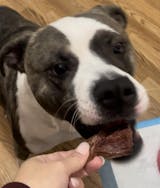As more and more people have become aware of the potential dangers of rawhide chews, similar terms have started popping up to avoid the negative stigma and differentiate their products. So now there are rawhide chews, cowhide chews, and beef hide for dogs.
But what’s the difference?
Short answer: marketing.
None of these are regulated labels, like “organic” is, for example. But these terms are used differently and understanding some of the distinctions (and risks) can make a big difference for your dog’s health. So let’s talk about what these terms mean and what you should be looking for.
Understanding Rawhide

Rawhide is a general term that can describe any type of animal hide. It can come from any animal, any country, and can be processed in almost any way. Most commercial rawhide is a by-product of the tanning process. Before the hide is made into leather, it’s often split. The thinner lower layer is turned into rawhide, while the top layer continues the tanning process and is turned into leather for shoes, purses, or anything else.
Because rawhides are made from this thinner layer of skin, they can break very easily into chunks that pose a choking hazard or can create blockages in the digestive tract. This danger, combined with the salt brines and lime used to preserve and process the hides, is a major reason why so many pet owners are looking for healthier alternatives to rawhide chews.
Understanding Cowhide and Beef Hide for Dogs

Cowhide and beef hide would still broadly be considered “rawhide”, but specifically rawhide made from cows. However, these terms are frequently used to describe natural chews that are healthier and safer than the highly processed rawhide that most people are familiar with. For example, here at Ugly Chews, we refer to our chews as cowhide or beef hide because they are 100% natural and sourced from local ranches.
Like us, there are other all-natural beef hide makers that follow similar processes. Unlike industrial rawhide, these hides aren’t split or thinned. They are the whole beef hide. The extra thickness makes them last longer and makes it less likely for large chunks to break off and create problematic blockages.
Our beef hides are also completely chemical and additive-free. We even keep the hair on them because dogs love it and it helps clean their teeth and digestive system. Some natural beef hide products have the hair removed, but it’s still more or less the same thing.
How To Cut Through The Marketing Tricks
If you want to pick the perfect chew treat for your canine companion, you need to look past simple descriptions like cowhide, beef hide, and rawhide. Instead, identify what’s important to you and find a company that meets those needs. You’ll probably need to read product descriptions and “About” pages more thoroughly to find the details. Here are some factors that may be important to you, and some key terms associated with them:
Price/Quality: Price is pretty easy. If price is your biggest concern, just look for the cheapest number. You will want to experiment with the actual price. That’s where quality comes in. For example, if a chew costs 25% more, but lasts twice as long, it is still more affordable than the “cheaper” option. Quality can be somewhat subjective. But for chews, durability and the dog’s enjoyment are pretty big factors.
Natural/Chemical-Free: If you want to make sure you aren’t feeding your dog any preservatives, additives, or chemicals, you should look out for companies advertising their treats as chemical and preservative-free. “Natural” can be a helpful descriptor, but it is pretty vague and you can legally call a lot of things natural. Ingredients labels will show any preservatives that are added, but they won’t reflect whether the hides were coated in lime or salt brine earlier in the process. Look for sections on the company website that details their manufacturing process. To be extra safe, you can send them an email and ask about it!
Sustainable/Environmentally Friendly: This is another one that can be tricky. Sustainable doesn’t have legal protections or certifications, so people can use it to mean different things. If you want to ensure that your dog treats are environmentally friendly, you should once again take a look at the manufacturing process. Hand-made treats are usually better than machine processed ones since most machines have a carbon footprint. Packaging is also a big factor. A product double-wrapped in single-use plastic is obviously less sustainable than a plastic-free product.
Healthy/Safe: What’s considered healthy and safe will depend on your dog. Of course, if you have a dog with a beef allergy, no beef products will be safe. Natural products that have no preservatives or chemicals reduce the risk of health complications from those additives, but the lack of preservatives introduces the small chance of bacteria or mold growing on the product. Almost every product has risks, but they are all incredibly small risks. It’s up to you to use caution and good judgment in deciding what fits your dog best. If a company claims that their product has absolutely no risk and is completely and perfectly safe…that’s a red flag. It’s better to look at disclaimers. A company with detailed disclaimers and instructions for reducing risk is much more likely to be telling the truth and providing transparent and accurate information.
Local/Ethical/Made in ______ : I know I’m lumping a lot of terms that feel different together on this one, but the concern is usually the same for all of them. We want to make sure that the animals and people involved in creating a product are being treated well. Factory farms and massive slaughter houses don’t always have the best reputation when it comes to animal welfare. Similarly, we don’t want products made by underpaid employees working in slave-like conditions, as is unfortunately common in some countries. It all comes back to knowing where your product is from and how it’s being handled. If a company can tell you exactly where the animals are from and how they were raised, that tends to be a good sign. People have different definitions of what counts as “ethically sourced” products, but this is another area where a company’s about page, FAQs, and contact info can come in handy.
Regardless of what’s important to you, don’t be afraid to dig into the details of a company more. The good ones shouldn’t have anything to hide. And every company is going to tell you that their product is the best. People who source their product from Brazil will say Brazil is amazing. People who freeze-dry their product will say that’s the best way. People who sell these things are biased. Shoot, we’ve tried to write this article in an unbiased way, but we still slipped a few shameless promotions of our products in there.
We do really think that Ugly Chews are a great choice if you’re looking for a local, chemical-free, zero-waste beef hide chew that your dog will absolutely love.















































